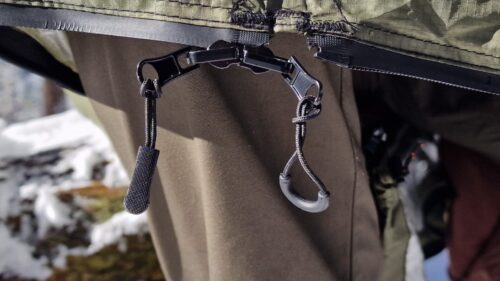Manual HIDEOUT 
The HIDEOUT gear lineup is designed to protect against cold, moisture, and insects as a bivi bag or sleeping bag, a rain poncho, a hammock under blanket, and also as a tarp.
Size:
HIDEOUT THERMO – 2,6m – 2,3m of the main part + 30 cm hood
HIDEOUT WARM – 2,3m – 2m of the main part + 30 cm hood
95 cm wide at the head side and 45 cm at the foot side.
When used as a bivi feets are usually at the level of 55cm width.
HIDEOUTa consists;
- Main part
- The hood
- 2x expanders
Along the bivy, there are 3 double waterproof zippers – at the feet, lower and upper. Each of them has two sliders equipped with pullers, “U” shape and “Claw” shaped pullers – for easier identification.
ATTENTION! Waterproof zippers have a protection level in accordance with PN-EN 60529:2003 at IP42. Properly used they are waterproof to rain but not water jets or immersion.
Unzipping with the Claw puller you can separate zippers completely. When unzipping the zipper with the “U” shape puller, it cannot be separated completely.
The zippers along the sleeping bag cover overlap. It provides better protection from the rain and better insulation.
Bivy bag/ sleeping bag
You get HIDEOUT ready to use as a bivi bag or as a sleeping bag depending on the type.
To enter it comfortably, open the upper zipper by pulling the U-shape puller so that the zipper reaches the end, i.e. the zipper with the Claw puller.
If you are using the HIDEOUT as a bivi bag, put the sleeping bag inside.
- Sit down and then slide inside and put the hood over your head.
- Lay down and fasten the previously opened zipper.
- If you do not plan to put on a mosquito net – close the upper part of the HIDEOUT with the welt located at the edge of the upper part. You will find the ends of the cord in the corners near the end of the zipper.
This will create a thermal collar around your arms.
REMEMBER! Using the cords, unlock the cord stoppers beforehand, pulling the cords without releasing the stoppers can damage the stoppers.
In the event of rain, you can turn around so that the hood covers your head from above, creating a roof.
Mosquito net
When lying in the bivi, you can put a mosquito net over your head and neck.
Before you create the thermal collar, unfasten the 6 snaps located on the edge of the hood.
The upper and side edges of the mosquito net are attached to the hood. The lower edge has a zipper.
- Zipp the lower edge of the mosquito net into the zipper on the edge of the HIDEOUT main opening. If you are lying on your back, you will find it at shoulder height.
- About the middle of the mosquito net, there is a wire reinforcement. Bend it so that the mosquito net does not touch your face.
- After setting the mosquito net, put your hands inside as well as free parts of the mosquito net.
- Close the upper hole of the HIDEOUT with the cord located at the edge of the upper hole. You will find the ends of the cord in the corners near the end of the lock.
This will create a thermal collar around your arms.
Poncho
- Fully open the zippers along the HIDEOUT using the Claw puller and remove the hood.
- Lay the main part flat and then fold it in half so that the short sides are one above the other.
- Zip up sides together, leaving aproximately 30cm slides for your hands.
- In the middle of the main part there is a zipper – unzip it completely and insert the hood there.
You can attach a mosquito net to the second part of the zipper. - Put the free ends of the mosquito net between the zippers loosely inside the poncho. These are slots that allow quick access to the face, e.g. to clean glasses.
- After putting on the poncho, you can gird yourself with one of the expanders.
Hammock under blanket
- Put the HIDEOUT in the previously hung hammock.
- Fully open the zippers along the HIDEOUT using the Claw puller sliders and remove the hood.
- In the corners of the main part, you will find small loops, insert expanders into them using the hooks located there,
- Attach the expander elastic cords to the carabiners of the hammock and wrap the hammock from the bottom with HIDEOUT.
- Adjust the main opening with the welt and adjust the other side with a zipper.
You can hang the free corner with the loop located there to one of the hooks of the expander.
Tarp
- Fully open the zippers along the HIDEOUT using the Claw puller sliders and remove the hood.
- Using the loops around the HIDEOUT and the expanders, you can create all kinds of shelters.
- Read about shelters in Tarpology
Safety
Safety of use and adjustment when HIDEOUT is used as a tarp, under blanket, or poncho is secured by flexible expanders. They are designed to take over any stresses arising during use. In the situation that the stresses or forces acting on the HIDEOUT are too big than the expanding capacity of the expanders, the flexible expander cord will slip out of the end hook. This is the warning and the intended protection against damage. In this way, the plastic hooks at the ends of the expanders act as fuses.
Inserting the end of the expander back into the hook is very easy – lift the flap on the top side of the hook, insert the end of the expander into the gap between the flap and the main part of the hook, and close the flap. Do not allow the end of the expander to slip out of the hook – this means that the forces and stresses acting on the HIDEOUT are too big and may cause damage not covered by the warranty.
Despite the fact that the outer material is waterproof and vapor permeable, intensive use of HIDEOUT can lead to moisture from the inside. It can come from both condensed water vapor (dew point) and after prolonged contact of the material with water.
These are natural phenomena.
REMEMBER! The fabric is not flame or spark resistant – keep it away form fire and sparks!
Repair patch
Each HIDEOUT comes with a repair patch in case something breaks.
Just clean and dry the damaged area.
Gently remove the adhesive surface protection and apply the patch.
Press down and wait 20 minutes – ready.


 The upper and side edges of the mosquito net are attached to the hood. The lower edge has a zipper.
The upper and side edges of the mosquito net are attached to the hood. The lower edge has a zipper.